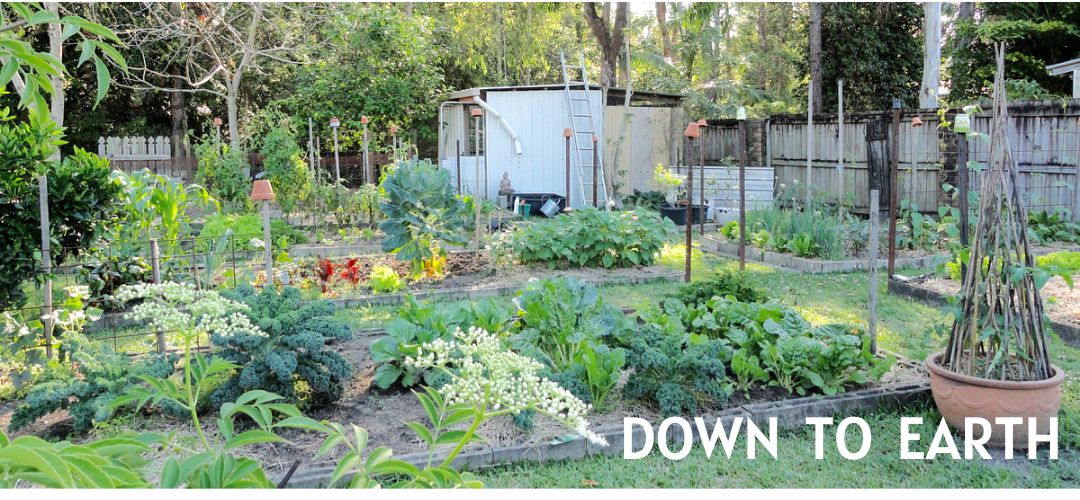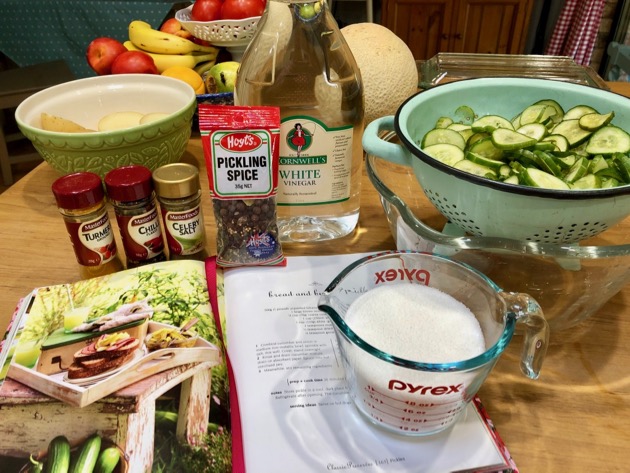Preserving small amounts of fruit and vegetables is a good way to minimise food waste, cut the cost of providing interesting food and a good way to introduce new, delicious food to kitchen table. Of course, you could buy bread and butter cucumbers, tomato relish or a spicy chutney from the supermarket or local co-op but nothing will be as good as what you prepare in your own kitchen. You can make your preserves exactly to your taste.
Here in Australia, we generally use UK methods of preserving which are different to those used in the US. If you're going to preserve more food, buy yourself a good preserving book as a guide. I use the Australian Women's Weekly preserving books, The River Cottage books and the WI book - Preserves by Carol Tennant, and read about salt, sugar, vinegar and safety before you dive right in.
Make sure you work in a clean kitchen, clean sink, clean hands, clean utensils. Wash and dry the jars and lids you intend to use. I had 1 kg (2.2lbs) cucumbers so I prepared 4 jars. I thought I might use three jars but had an extra one just in case I was wrong. If you don't use your spare jar, you can store any leftover pickling liquid in it to use in salads.
You don't need any fancy equipment to start preserving. When all our grandmas and great grandmas made jam, relish or pickles, they used what they had at hand and usually that was recycled jars and a saucepan. When you have your jars, look under the lids to make sure there's no rust, pin holes or damage and the rubber ring on the inside of the lid is in perfect condition. When that starts to perish, it won't provide a vacuum seal - throw it out. Check the glass too by running your fingers over the top of the jar. If you feel any chips or cracks, throw it out. Your equipment and your ingredients must be in the best condition possible. Once you've checked everything, sterilise the jars.
Sterilising the jars:
- In a saucepan - bring to the boil, then boil for 20 minutes in a large pot with all jars lying on their sides and completely under the water.
- In the oven - place on an oven tray, jars not touching, and put in preheated 150C/300F oven for 15 - 20 minutes
- In the dishwasher - put in the dishwasher on the hot wash. Don't use dishwasher detergent.
When the jars are ready to be removed from the sterilising space, pick them up with tongs, a mitt or tea towel, making sure you don't touch the inside - which is now sterile. Do the same with the lids - don't touch the inside. Place them all on the kitchen bench on a board or tea towel.
It's important that you have the jars ready to fill and still hot, when the pickling liquid is ready. If you don't have hot jars and hot liquid, you might not get the jars to vacuum seal properly.
BREAD AND BUTTER CUCUMBERS
- 1kg/2.2lbs cucumbers - don't use vegetables that are not perfect
- 1 onion
- ¼ cup cooking salt, pickling salt, kosher salt, rock salt - don't use salt with iodine
The day before you make the pickles:
- The day before you make your pickles, wash the cucumbers, skin the onion and cut everything finely. I use a mandolin for this. Put the cucumbers and onion in a glass or ceramic bowl, cover with the salt, mix it through with your hands to make sure everything is covered.
- Cover the bowl and leave overnight. This step is very important. It helps remove a lot of liquid from the cucumbers which if not removed pre-pickling, will release into the jar when you've added your liquid and it will dilute the taste. More importantly, it will probably put out the ratios of sugar and vinegar necessary for a successful and healthy pickle.
Pickling day:
The next morning, pour the cucumbers into a colander and wash the salt off. Make sure you do this properly because excess salt will spoil the pickles. Allow the cucumbers to drain for about an hour, or if you want to carry on immediately, place the cucumbers on a clean tea towel and dry them carefully that way.
While the cucumbers are draining start preparing your pickling liquid. Remember, the hot jars and the hot pickling liquid must be ready at the same time.
Pickling liquid:
- 2 cups/500ml white vinegar
- 1 - 2 cups/220g white sugar - depending on your taste. I use 2 cups sugar because I like a slightly sweet pickle and it balances the vinegar nicely.
- pickling spices - you can either buy pickling spice or use a mix of mustard seeds, peppercorns, celery seeds, dill seeds, allspice berries and bay leaves. Or if you don't like that mix just use mustard seeds, celery seeds, and pepper. I also add chilli flakes and a ¼ teaspoon turmeric.
- pickling herbs - when I'm growing it in the garden, I add sprigs of dill and I often add a bay leaf to each jar.
In a small saucepan, add all the above and bring to the boil. Take it off the heat as soon as it reaches boiling point, don't let it continue to boil.
Above are the pickling spices and below you can see the mixture after the turmeric was added.
Packing the jars:
- When the cucumbers have drained, using tongs, pack them into the hot jars. Push down gently so you get in as much as possible.
- Fill all your jars, then pour the pickling liquid into the jars, filling each jar to the top.
- Put on the lid and secure tightly.
- As the jars cool, you should hear the lid "pop" when it seals properly. Before you store the jars, push down the centre of the lid and if the lid hasn't sealed you'll be able to press the lid in slightly. If that happens, store the jar in the fridge, not the cupboard.
These bread and butter cucumbers will be ready to eat in 2 - 3 weeks. By then the vinegar will have mellowed and balanced out. I store all of my jars in the fridge but many cooks store theirs in a cupboard until they open the jar, and then in the fridge.
I have older bread and butter cucumbers that we'll have with cold corned beef and potato salad for today's lunch. It's always satisfying to have follow up jars of any homemade preserves waiting to be used. That is why this is a good first recipe - it's small scale, easy and straight forward. This is one of the most simple preserves you can make. I hope it opens up the world of preserving to you because homemade pickles, jams and bottled fruit will add a new dimension to your cooking.















